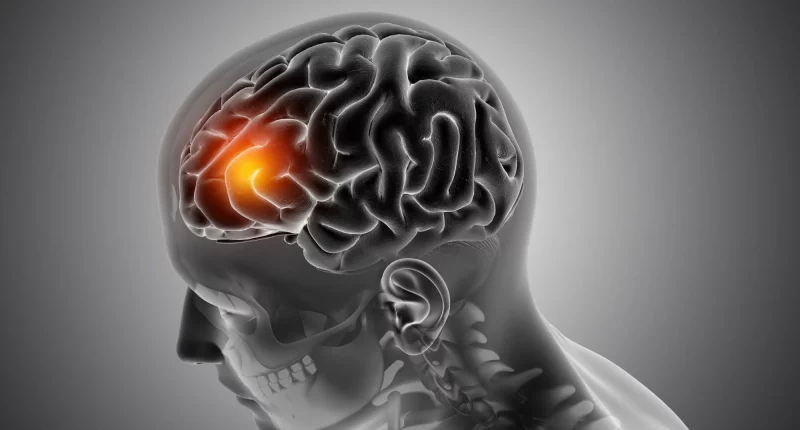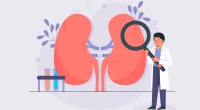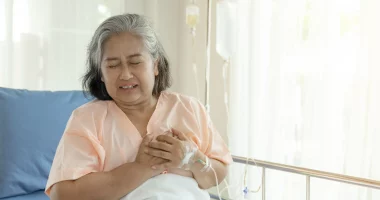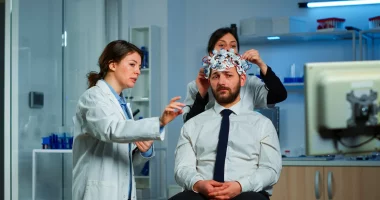A basal ganglia stroke happens when something blocks blood flow to the basal ganglia, a crucial area of the brain that helps send messages, control movement, and manage emotions.
A stroke happens when blood can’t reach the area of the brain or when a blood vessel in the brain bursts, releasing blood into the tissue of the brain. If this happens in the basal ganglia area, it’s known as basal ganglia stroke.
Signs of a stroke involve sudden weakness in one part of the body, trouble balancing, headaches, confusion, and trouble speaking. With a basal ganglia stroke, additional symptoms might include reduced emotions, lack of interest, and delayed or slow movements.
All strokes are serious medical emergencies and require immediate attention.
What is it?
A basal ganglia stroke occurs when blood flow to this critical area of the brain is restricted or completely blocked. Blood carries oxygen to the brain, and without enough oxygen, brain cells in the basal ganglia can be damaged or die.
Located deep within the brain, the basal ganglia are a cluster of cell bodies that act as a central hub for controlling several important bodily functions. These include movement coordination and learning, influencing behavior and emotions, and managing executive functions. Executive functions are mental processes that allow people to plan, concentrate, remember instructions, and multitask effectively.
Types
Basal ganglia strokes can for various reasons, be similar to other types of strokes. Here are the main types:
- Ischemic Stroke: This occurs when a blood clot stops a blood vessel that supplies oxygen to the brain. Without enough oxygen, brain cells start to become fatal.
- Hemorrhagic Stroke: This type happens when a blood vessel in the brain bursts or leaks, allowing blood to accumulate in the brain tissue. This buildup can cause pressure and swelling, potentially leading to brain damage. Several basal ganglia strokes are hemorrhagic and often result from hypertension.
- Childhood Basal Ganglia Stroke: A study in 2016 involving thirty-five children aged six months to twelve years who had basal ganglia strokes, 74 percent were caused by head trauma. Other causes included chickenpox in one child, Moyamoya disease in two, and high levels of homocysteine in the blood in one, and the cause was unclear in four children.
- Transient Ischemic Attack: It is also called “mini-strokes,” TIAs occur when blood flow to the brain is briefly blocked, usually for less than 5 minutes. They can be warning signs that a serious stroke might occur soon. About 10 to 15% of individuals who experience a TIA go on to have a major stroke within the next three months.
Symptoms
Recognizing the symptoms of a stroke is crucial for prompt medical intervention, which can potentially save lives or decrease the chance of severe disability.
Common signs of a stroke involve sudden weakness or numbness on one side of the face, leg, or arm, difficulty speaking or sudden confusion, a severe headache, trouble walking, impaired balance, sudden vision problems, and drooping.
However, identifying a basal ganglia stroke can be more challenging because it may present with different features. These can include apathy, slow movements, memory issues, lack of emotions, reduced initiative, disregard for social norms, slow actions, and loss of awareness.
Any individual experiencing these symptoms, whether for themselves or someone else, should need immediate medical help. Early intervention is crucial for the best possible outcomes.
Treatment
Basal ganglia stroke treatment hinges on the stroke type and the speed of medical intervention.
Depending on the stroke’s cause and other considerations, doctors might suggest clot-dissolving medications to dissolve clots, procedures to repair ruptured blood vessels, or surgeries like clipping an aneurysm to halt bleeding. If hypertension triggered the stroke, treatments could include procedures to lower blood pressure.
Recovery and Outlook
While some people may fully recover, others may face significant changes that impact their daily lives.
The recovery process is unique for each person, and it’s challenging to predict its duration or the extent of improvement because strokes affect people differently. Experts emphasize that predicting recovery after a basal ganglia stroke can be particularly challenging. The outcome depends on various factors, including the severity of the stroke and the individual’s overall health.
Supportive care and rehabilitation are crucial parts of recovery, aimed at helping individuals regain function and adjust to any lasting effects of the stroke.
Risk factors
Certain individuals face a higher chance of experiencing a basal ganglia stroke compared to others, based on various factors.
Studies suggest that older individuals with lower body mass indexes (BMI) and calcifications on their basal ganglia might be more susceptible to these kinds of strokes. Additionally, several other factors can increase the risk of any stroke, including a personal or family history of stroke or transient ischemic attacks (TIAs), hypertension, blood vessel and heart diseases like atrial fibrillation or high LDL cholesterol, smoking, diabetes, and the presence of a brain aneurysm, which heightens the chance of brain bleeding.
Age is also a significant factor, with both very young children and older adults being more vulnerable. Mental health conditions such as depression, anxiety, or high-stress levels, along with certain medical conditions like kidney disease or sickle cell disease, and the use of specific medications such as blood thinners, can further elevate risk. Lifestyle choices such as lack of regular physical activity, use of recreational drugs like cocaine, excessive alcohol consumption, and poor dietary habits also contribute to increased stroke risk.
Prevention
Preventing a stroke isn’t always within complete control, but certain lifestyle alternatives can significantly reduce the risk.
Managing a moderate weight, following a balanced diet, and engaging in regular exercise are key factors. Managing conditions like hypertension and diabetes, which increase stroke chances, is also crucial. Ceasing smoking, reducing alcohol intake, ensuring adequate and quality sleep, and effectively handling stress can further lower the likelihood of a stroke.
While it’s impossible to eliminate every risk element, individuals can take immediate steps to minimize their chances of experiencing a stroke. By adopting healthy habits and managing underlying health conditions, people can proactively safeguard their health and well-being.
Summary
Basal ganglia strokes occur when blood flow to this brain region is blocked or interrupted, leading to diverse symptoms including movement difficulties and emotional changes. These strokes can result from conditions like high blood pressure or head trauma, affecting recovery and long-term outcomes.
Treatment options range from clot-dissolving medications to surgical interventions, tailored to the stroke type and severity. Recovery varies widely among individuals, influenced by prompt treatment, targeted therapies, and the extent of brain damage. Rehabilitation plays a crucial role, involving therapies like occupational and speech therapy, along with support for daily living. Advanced imaging techniques like DTI offer insights into stroke effects and aid in predicting recovery potential.
External links









